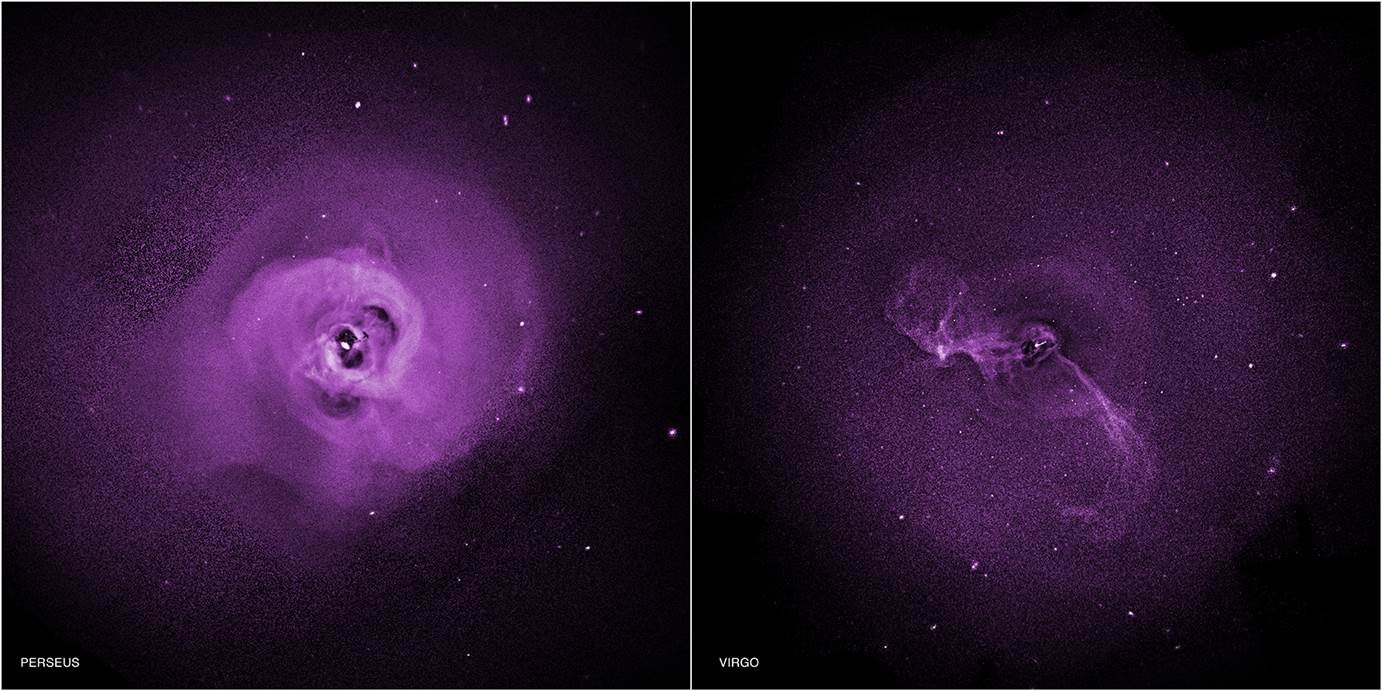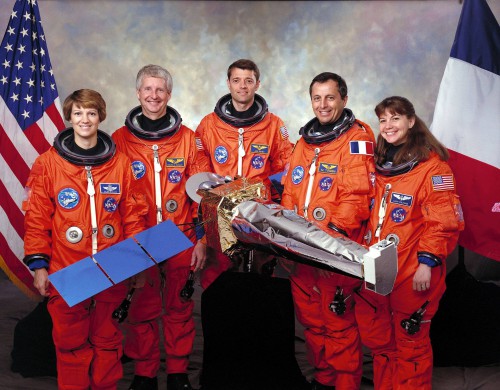
This week, NASA announced that the Chandra X-ray Observatory, now in its 15th year of operation and described as “NASA’s flagship mission for X-ray astronomy,” may have discovered why some galaxy clusters do not form stars as expected: turbulence, the same kind that plagues airplane flights in poor weather. While people on Earth definitely don’t enjoy the effects of turbulence, it turns out that the phenomenon also may not be conducive to the genesis of stars.
Chandra observed several galaxy clusters including Perseus and Virgo (as shown in the image above), which are swathed in gas clouds; at the center of these galaxies, large black holes are apparent. The chaotic interaction of the gas and the black holes are believed to have caused these galaxies to prevent forming many stars. Perseus and Virgo were targeted specifically because of their brightness and size.
These findings were published by Stanford University in Palo Alto, Calif., in the journal Nature. Irina Zhuravleva, who led the study that featured contributions by a number of authors and researchers, stated: “We knew that somehow the gas in clusters is being heated to prevent it cooling and forming stars. The question was exactly how. We think we may have found evidence that the heat is channeled from turbulent motions, which we identify from signatures recorded in X-ray images.”
Information from Chandra’s website explains why these galaxies may have not formed stars over time. Galaxy clusters, held together by gravity, are the largest objects in the Universe, which can contain hundreds to thousands of galaxies. Chandra, along with other x-ray observatories, can detect the very hot gases in these galaxies, which appear to “glow” in x-ray light. The gases should have cooled down over time, aiding in the formation of stars within these galaxies. However, this does not always happen. A possible answer to this conundrum: The galaxies have super-massive black holes in their middles. Black holes emit jets which carve out “cavities,” visible in the central parts of the galaxy clusters in these images.
It is theorized in the paper published in Nature that these “cavities” may have created turbulence within the galaxies, keeping the hot gases hot, preventing any star-forming cooling for billions of years. A co-author, Eugene Churazov of the Max Planck Institute for Astrophysics in Munich, Germany, spoke further about the theory set forth in the paper: “Any gas motions from the turbulence will eventually decay, releasing their energy to the gas. But the gas won’t cool if turbulence is strong enough and generated often enough.” The team, using data gleaned from Chandra, also analyzed the density of the gases in Perseus and Virgo in a bid to gauge the amounts of turbulence generated.
Alexander Schekochihin of the University of Oxford in the United Kingdom, who also contributed to the study, stated: “Our work gives us an estimate of how much turbulence is generated in these clusters. From what we’ve determined so far, there’s enough turbulence to balance the cooling of the gas.” The turbulence is also shown by the telltale “ripples” generated near the black holes, shown in the images of Perseus and Virgo above.

This discovery is one of a great many to have earned Chandra’s name in x-ray astronomy’s canon. While Earth-based telescopes have contributed much to astronomy, x-rays are absorbed by the Earth’s atmosphere, making a space-based telescope desirable. Enter Chandra X-ray Observatory, originally designated as the Advanced X-ray Astrophysics Facility (AXAF).
Operating at an extremely elliptical orbit around our planet, Chandra was deployed by STS-93 (Columbia) in July 1999, a mission also historically notable in that it was the first space shuttle mission commanded by a woman (Eileen Collins). It is part of the “Great Observatories” program (which also includes the Hubble Space Telescope, deployed in 1990 and nearing its 25th year of operation).
While its planned lifespan was five years, it is still operational following 15 years. Chandra is managed by NASA’s Marshall Spaceflight Center in Huntsville, Ala., and is controlled by the Smithsonian Astrophysical Observatory in Cambridge, Mass.
Another space telescope, the James Webb Space Telescope (JWST), has passed several developmental milestones this year, and is slated for a 2018 launch from an Ariane 5 rocket from Europe’s Spaceport in Kourou, French Guiana. Chandra and its “siblings” will undoubtedly uncover more mysteries of the Universe to fire the imaginations of generations to come.
Note: A correction was made to this piece as Jonathan McDowell pointed out: ” … What happens is that the supermassive black holes emit relativistic jets (visible in the right hand image) which carve out cavities in the cluster gas, which then create the turbulence. When they are talking about cavities, they mean the huge regions cleared by the jets, not the black hole in the middle that is responsible.” Thank you, Jonathan, for clarifying.
Want to keep up-to-date with all things space? Be sure to “Like” AmericaSpace on Facebook and follow us on Twitter: @AmericaSpace



